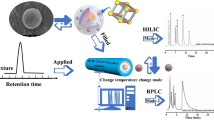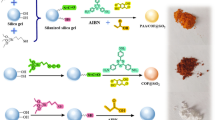Abstract
The synthesis of two-dimensional metal–organic frameworks (2D MOFs)/polymer core–shell composites is reported which were composed of polydopamine modified 2D Zr-1,3,5-(4-carboxylphenyl)-benzene (2D Zr-BTB) nanosheets and silica microspheres via a double-solvent approach. In this way, the composites were obtained under the condition of two solvents with different polarities to avoid agglomeration and uneven modification of most MOFs particles on the surface of the silica, existing inevitably in the one-pot method. Compared with the reported MOFs@silica composites adopting one-pot solvent method, the prepared composites exhibited significantly enhanced separation performance for sulfonamides, antibiotics, nucleosides, and polycyclic aromatic hydrocarbons compounds. Furthermore, the retention mechanisms were demonstrated by studying the relationships of chromatographic retention factors of tested analytes versus a variety of parameters under RPLC and HILIC modes, respectively. The superior chromatographic repeatability and stability were validated through the relative standard deviations of the retention time and/or column efficiency, which were found to be less than 0.8% and 0.9%, respectively. The material showed efficient separation ability for several types of compounds and provided another selectivity for preparing composites based on 2D MOFs nanosheets and other functional molecules.
Graphical abstract








Similar content being viewed by others
References
Yan W, Li S, Yang T, Xia Y, Zhang X, Wang C, Yan Z, Deng F, Zhou Q, Deng H (2020) Molecular vises for precisely positioning ligands near catalytic metal centers in metal-organic frameworks. J Am Chem Soc 142(38):16182–16187
Yang Y, Zhang X, Kanchanakungwankul S, Lu Z, Noh H, Syed ZH, Farha OK, Truhlar DG, Hupp JT (2020) Unexpected “spontaneous” evolution of catalytic, MOF-supported single Cu(II) cations to catalytic, MOF-supported Cu(0) nanoparticles. J Am Chem Soc 142(50):21169–21177
Jiang Z, Xu X, Ma Y, Cho HS, Ding D, Wang C, Wu J, Oleynikov P, Jia M, Cheng J, Zhou Y, Terasaki O, Peng T, Zan L, Deng H (2020) Filling metal-organic framework mesopores with TiO2 for CO2 photoreduction. Nature 586(7830):549–554
Zhu D, Zhang Y, Bao S, Wang N, Yu S, Luo R, Ma J, Ju H, Lei J (2021) Dual intrareticular oxidation of mixed-ligand metal-organic frameworks for stepwise electrochemiluminescence. J Am Chem Soc 143(8):3049–3053
Wang Y, Zhao G, Chi H, Yang S, Niu Q, Wu D, Cao W, Li T, Ma H, Wei Q (2021) Self-luminescent lanthanide metal-organic frameworks as signal probes in electrochemiluminescence immunoassay. J Am Chem Soc 143(1):504–512
Qu C, Jiao Y, Zhao B, Chen D, Zou R, Walton KS, Liu M (2016) Nickel-based pillared MOFs for high-performance supercapacitors: design, synthesis and stability study. Nano Energy 26:66–73
Hu A, Pang Q, Tang C, Bao J, Liu H, Ba K, Xie S, Chen J, Chen J, Yue Y, Tang Y, Li Q, Sun Z (2019) Epitaxial growth and integration of insulating metal-organic frameworks in electrochemistry. J Am Chem Soc 141(28):11322–11327
Yu MH, Space B, Franz D, Zhou W, He C, Li L, Krishna R, Chang Z, Li W, Hu TL, Bu XH (2019) Enhanced gas uptake in a microporous metal-organic framework via a sorbate induced-fit mechanism. J Am Chem Soc 141(44):17703–17712
Li JR, Kuppler RJ, Zhou HC (2009) Selective gas adsorption and separation in metal-organic frameworks. Chem Soc Rev 38(5):1477–1504
Ahmed A, Seth S, Purewal J, Wong-Foy AG, Veenstra M, Matzger AJ, Siegel DJ (2019) Exceptional hydrogen storage achieved by screening nearly half a million metal-organic frameworks. Nat Commun 10(1):1568
Liu Q, Song Y, Ma Y, Zhou Y, Cong H, Wang C, Wu J, Hu G, O’Keeffe M, Deng H (2019) Mesoporous cages in chemically robust MOFs created by a large number of vertices with reduced connectivity. J Am Chem Soc 141(1):488–496
Yang SS, Chang YJ, Zhang H, Yu X, Shang W, Chen GQ, Chen DDY, Gu ZY (2018) Enrichment of phosphorylated peptides with metal-organic framework nanosheets for serum profiling of diabetes and phosphoproteomics analysis. Anal Chem 90(22):13796–13805
Lin S, Zhao Y, Yun YS (2018) Highly effective removal of nonsteroidal anti-inflammatory pharmaceuticals from water by Zr(IV)-based metal-organic framework: adsorption performance and mechanisms. ACS Appl Mater Interfaces 10(33):28076–28085
Wu X, Shao Y, Hu B, Wang J, Hou X (2020) Preparation and application of novel MIL-101(Cr) composite in liquid chromatographic separation of aromatic compounds: experimental and computational insights. Mikrochim Acta 187(8):471
Si T, Wang S, Zhang H, Wang L, Lu X, Liang X, Guo Y (2021) Design and evaluation of novel MOF-polymer core-shell composite as mixed-mode stationary phase for high performance liquid chromatography. Mikrochim Acta 188(3):76
Yang S, Peng L, Syzgantseva OA, Trukhina O, Kochetygov I, Justin A, Sun DT, Abedini H, Syzgantseva MA, Oveisi E, Lu G, Queen WL (2020) Preparation of highly porous metal-organic framework beads for metal extraction from liquid streams. J Am Chem Soc 142(31):13415–13425
Chen G, Huang S, Kou X, Zhu F, Ouyang G (2020) Embedding functional biomacromolecules within peptide-directed metal-organic framework (MOF) nanoarchitectures enables activity enhancement. Angew Chem Int Ed Engl 59(33):13947–13954
Peng L, Yang S, Sun DT, Asgari M, Queen WL (2018) MOF/polymer composite synthesized using a double solvent method offers enhanced water and CO2 adsorption properties. Chem Commun (Camb) 54(75):10602–10605
Liu C, Sun Q, Lin L, Wang J, Zhang C, Xia C, Bao T, Wan J, Huang R, Zou J, Yu C (2020) Ternary MOF-on-MOF heterostructures with controllable architectural and compositional complexity via multiple selective assembly. Nat Commun 11(1):4971
Mizutani N, Hosono N, Le Ouay B, Kitao T, Matsuura R, Kubo T, Uemura T (2020) Recognition of polymer terminus by metal-organic frameworks enabling chromatographic separation of polymers. J Am Chem Soc 142(8):3701–3705
Karmakar A, Mileo PGM, Bok I, Peh SB, Zhang J, Yuan H, Maurin G, Zhao D (2020) Thermo-responsive MOF/polymer composites for temperature-mediated water capture and release. Angew Chem Int Ed Engl 59(27):11003–11009
Rui K, Zhao G, Chen Y, Lin Y, Zhou Q, Chen J, Zhu J, Sun W, Huang W, Dou SX (2018) Hybrid 2D dual-metal-organic frameworks for enhanced water oxidation catalysis. Adv Func Mater 28(26):1801554
Jia H, Yao Y, Zhao J, Gao Y, Luo Z, Du P (2018) A novel two-dimensional nickel phthalocyanine-based metal–organic framework for highly efficient water oxidation catalysis. J Mater Chem A 6(3):1188–1195
Xia H, Zhang J, Yang Z, Guo S, Guo S, Xu Q (2017) 2D MOF nanoflake-assembled spherical microstructures for enhanced supercapacitor and electrocatalysis Performances. Nanomicro Lett 9(4):43
Tao ZR, Wu JX, Zhao YJ, Xu M, Tang WQ, Zhang QH, Gu L, Liu DH, Gu ZY (2019) Untwisted restacking of two-dimensional metal-organic framework nanosheets for highly selective isomer separations. Nat Commun 10(1):2911
Si T, Song X, Wang L, Guo Y, Liang X, Wang S (2020) Preparation and evaluation of hydrophobically associating polyacrylamide coated silica composite as high performance liquid chromatographic stationary phase. Microchem J 152:104330
Juliette van der Meer IB-G, Mercier C, Revel B, Davidson A, Denoyel R (2010) Mechanism of metal oxide nanoparticle loading in SBA-15 by the double solvent technique. J Phys Chem C 114:3507–3515
Hao Z, Xiao B, Weng N (2008) Impact of column temperature and mobile phase components on selectivity of hydrophilic interaction chromatography (HILIC). J Sep Sci 31(9):1449–1464
Guo Y, Gaiki S (2011) Retention and selectivity of stationary phases for hydrophilic interaction chromatography. J Chromatogr A 1218(35):5920–5938
Taraji M, Haddad PR, Amos RIJ, Talebi M, Szucs R, Dolan JW, Pohl CA (2018) Chemometric-assisted method development in hydrophilic interaction liquid chromatography: a review. Anal Chim Acta 1000:20–40
Xia H, Wang J, Chen G, Liu J, Wan G, Bai Q (2019) One-pot synthesis of SiO2@SiO2 core-shell microspheres with controllable mesopore size as a new stationary phase for fast HPLC separation of alkyl benzenes and beta-agonists. Mikrochim Acta 186(2):125
Alvarez-Segura T, Cabo-Calvet E, Baeza-Baeza JJ, Garcia-Alvarez-Coque MC (2019) Study of the column efficiency using gradient elution based on Van Deemter plots. J Chromatogr A 1584:126–134
Funding
This study was supported by National Science Foundation of China (No. 21575149 and No. 21505146).
Author information
Authors and Affiliations
Corresponding authors
Ethics declarations
Conflict of interest
The authors declare no competing interests.
Additional information
Publisher's note
Springer Nature remains neutral with regard to jurisdictional claims in published maps and institutional affiliations.
Supplementary Information
Below is the link to the electronic supplementary material.
Rights and permissions
About this article
Cite this article
Si, T., Lu, X., Zhang, H. et al. Fabrication of two-dimensional metal–organic framework nanosheets/PDA composites as mixed-mode stationary phase for chromatographic separation. Microchim Acta 188, 360 (2021). https://doi.org/10.1007/s00604-021-05023-5
Received:
Accepted:
Published:
DOI: https://doi.org/10.1007/s00604-021-05023-5




